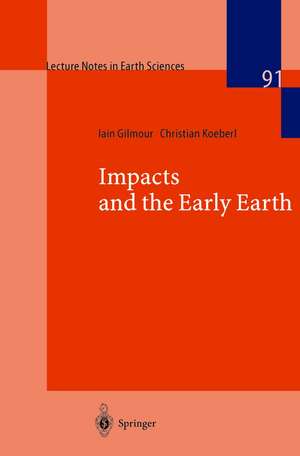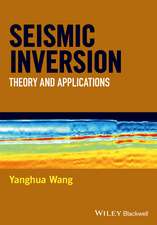Impacts and the Early Earth: Lecture Notes in Earth Sciences, cartea 91
Editat de Iain Gilmour, Christian Koeberlen Limba Engleză Paperback – 26 mai 2000
Din seria Lecture Notes in Earth Sciences
- 18%
 Preț: 944.99 lei
Preț: 944.99 lei -
 Preț: 402.38 lei
Preț: 402.38 lei - 15%
 Preț: 641.71 lei
Preț: 641.71 lei - 15%
 Preț: 637.46 lei
Preț: 637.46 lei - 15%
 Preț: 643.34 lei
Preț: 643.34 lei - 15%
 Preț: 644.82 lei
Preț: 644.82 lei - 15%
 Preț: 639.59 lei
Preț: 639.59 lei - 18%
 Preț: 1248.33 lei
Preț: 1248.33 lei - 15%
 Preț: 643.99 lei
Preț: 643.99 lei - 18%
 Preț: 1222.94 lei
Preț: 1222.94 lei - 18%
 Preț: 957.62 lei
Preț: 957.62 lei - 18%
 Preț: 1001.19 lei
Preț: 1001.19 lei -
 Preț: 384.48 lei
Preț: 384.48 lei - 18%
 Preț: 951.29 lei
Preț: 951.29 lei - 18%
 Preț: 954.45 lei
Preț: 954.45 lei - 15%
 Preț: 637.59 lei
Preț: 637.59 lei - 18%
 Preț: 943.43 lei
Preț: 943.43 lei - 18%
 Preț: 1228.29 lei
Preț: 1228.29 lei - 18%
 Preț: 950.33 lei
Preț: 950.33 lei - 18%
 Preț: 955.25 lei
Preț: 955.25 lei -
 Preț: 397.59 lei
Preț: 397.59 lei - 18%
 Preț: 946.55 lei
Preț: 946.55 lei - 23%
 Preț: 871.21 lei
Preț: 871.21 lei - 18%
 Preț: 1005.74 lei
Preț: 1005.74 lei - 15%
 Preț: 635.80 lei
Preț: 635.80 lei - 18%
 Preț: 943.08 lei
Preț: 943.08 lei - 18%
 Preț: 946.41 lei
Preț: 946.41 lei -
 Preț: 382.57 lei
Preț: 382.57 lei - 18%
 Preț: 957.62 lei
Preț: 957.62 lei
Preț: 397.97 lei
Nou
Puncte Express: 597
Preț estimativ în valută:
76.15€ • 79.72$ • 63.01£
76.15€ • 79.72$ • 63.01£
Carte tipărită la comandă
Livrare economică 05-19 aprilie
Preluare comenzi: 021 569.72.76
Specificații
ISBN-13: 9783540670926
ISBN-10: 3540670920
Pagini: 468
Ilustrații: XVIII, 448 p. 185 illus., 4 illus. in color.
Dimensiuni: 155 x 235 x 25 mm
Greutate: 0.65 kg
Editura: Springer Berlin, Heidelberg
Colecția Springer
Seria Lecture Notes in Earth Sciences
Locul publicării:Berlin, Heidelberg, Germany
ISBN-10: 3540670920
Pagini: 468
Ilustrații: XVIII, 448 p. 185 illus., 4 illus. in color.
Dimensiuni: 155 x 235 x 25 mm
Greutate: 0.65 kg
Editura: Springer Berlin, Heidelberg
Colecția Springer
Seria Lecture Notes in Earth Sciences
Locul publicării:Berlin, Heidelberg, Germany
Public țintă
ResearchCuprins
Exobiology: Laboratory tests of the impact related aspects of Panspermia.- Macromolecular organic materials in carbonaceous chondrites: A review of their sources and their role in the origin of life on the early earth.- Effects of atmospheric heating on infalling meteorites and micrometeorites: Relevance to conditions on the early earth.- Search for petrographic and geochemical evidence for the late heavy bombardment on earth in early archean rocks from Isua, Greenland.- The oldest impact deposits on earth — First confirmation of an extraterrestrial component.- Early archean spherule beds in the Barberton mountain land, South Africa: Impact or terrestrial origin?.- Particles in late archean carawine dolomite (Western Australia) resemble muong nong-type tektites.- Fossil micrometeorites from Finland — Basic features, scientific potential, and characteristics of the mesoproterozoic host rocks.- Impact diamonds as indicators of shock metamorphism in strongly-reworked Pre-Cambrian impactites.- Deeply exhumed impact structures: A case study of the Vredefort structure, South Africa.- Identification of ancient impact structures: Low-angle faults and related geological features of crater basements.- Basic remote sensing signatures of large, deeply eroded impact structures.- The terrestrial cratering rate over the last 125 million years.- Impact melting of carbonates from the Chicxulub crater.- The Gallejaur structure, Northern Sweden.- Neugrund structure — the newly discovered submarine early Cambrian impact crater.- Impact-induced replacement of plagioclase by K-feldspar in granitoids and amphibolites at the Kärdla Crater, Estonia.
Textul de pe ultima copertă
Only 10% of the 150 or so known impact craters on Earth date from the early Precambrian Era, a time period covering 88% of the Earths history. Yet this Era encompasses events in the origin and evolution of our planet from the origin of life itself to the developments of the continents. The papers in this volume were presented at a workshop sponsored by the European Science Foundation Scientific Network on Impact cratering held in Cambridge, UK, in December 1998. The papers outline the present state of scientific understanding of the role impacts may have played in the biological and geological evolution of the Early Earth.













